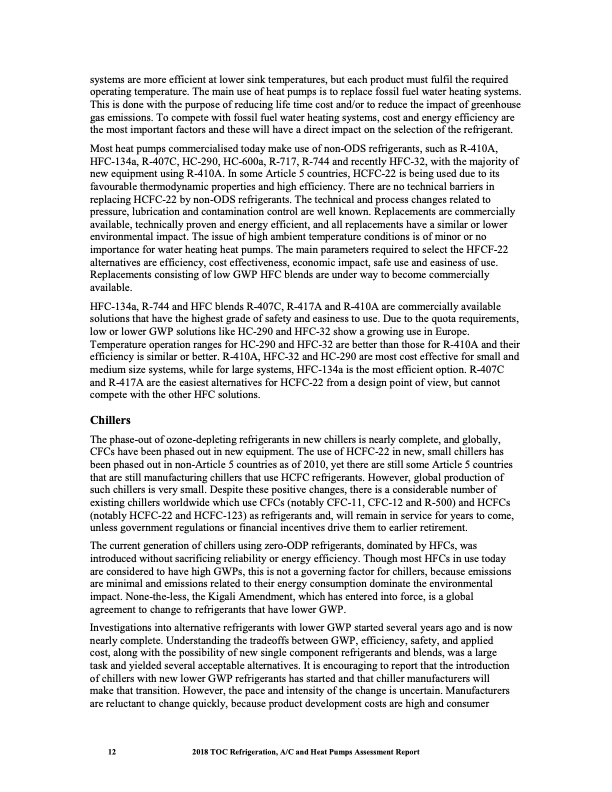
PDF Publication Title:
Text from PDF Page: 025
systems are more efficient at lower sink temperatures, but each product must fulfil the required operating temperature. The main use of heat pumps is to replace fossil fuel water heating systems. This is done with the purpose of reducing life time cost and/or to reduce the impact of greenhouse gas emissions. To compete with fossil fuel water heating systems, cost and energy efficiency are the most important factors and these will have a direct impact on the selection of the refrigerant. Most heat pumps commercialised today make use of non-ODS refrigerants, such as R-410A, HFC-134a, R-407C, HC-290, HC-600a, R-717, R-744 and recently HFC-32, with the majority of new equipment using R-410A. In some Article 5 countries, HCFC-22 is being used due to its favourable thermodynamic properties and high efficiency. There are no technical barriers in replacing HCFC-22 by non-ODS refrigerants. The technical and process changes related to pressure, lubrication and contamination control are well known. Replacements are commercially available, technically proven and energy efficient, and all replacements have a similar or lower environmental impact. The issue of high ambient temperature conditions is of minor or no importance for water heating heat pumps. The main parameters required to select the HFCF-22 alternatives are efficiency, cost effectiveness, economic impact, safe use and easiness of use. Replacements consisting of low GWP HFC blends are under way to become commercially available. HFC-134a, R-744 and HFC blends R-407C, R-417A and R-410A are commercially available solutions that have the highest grade of safety and easiness to use. Due to the quota requirements, low or lower GWP solutions like HC-290 and HFC-32 show a growing use in Europe. Temperature operation ranges for HC-290 and HFC-32 are better than those for R-410A and their efficiency is similar or better. R-410A, HFC-32 and HC-290 are most cost effective for small and medium size systems, while for large systems, HFC-134a is the most efficient option. R-407C and R-417A are the easiest alternatives for HCFC-22 from a design point of view, but cannot compete with the other HFC solutions. Chillers The phase-out of ozone-depleting refrigerants in new chillers is nearly complete, and globally, CFCs have been phased out in new equipment. The use of HCFC-22 in new, small chillers has been phased out in non-Article 5 countries as of 2010, yet there are still some Article 5 countries that are still manufacturing chillers that use HCFC refrigerants. However, global production of such chillers is very small. Despite these positive changes, there is a considerable number of existing chillers worldwide which use CFCs (notably CFC-11, CFC-12 and R-500) and HCFCs (notably HCFC-22 and HCFC-123) as refrigerants and, will remain in service for years to come, unless government regulations or financial incentives drive them to earlier retirement. The current generation of chillers using zero-ODP refrigerants, dominated by HFCs, was introduced without sacrificing reliability or energy efficiency. Though most HFCs in use today are considered to have high GWPs, this is not a governing factor for chillers, because emissions are minimal and emissions related to their energy consumption dominate the environmental impact. None-the-less, the Kigali Amendment, which has entered into force, is a global agreement to change to refrigerants that have lower GWP. Investigations into alternative refrigerants with lower GWP started several years ago and is now nearly complete. Understanding the tradeoffs between GWP, efficiency, safety, and applied cost, along with the possibility of new single component refrigerants and blends, was a large task and yielded several acceptable alternatives. It is encouraging to report that the introduction of chillers with new lower GWP refrigerants has started and that chiller manufacturers will make that transition. However, the pace and intensity of the change is uncertain. Manufacturers are reluctant to change quickly, because product development costs are high and consumer 12 2018 TOC Refrigeration, A/C and Heat Pumps Assessment ReportPDF Image | Heat Pumps Technical Options

PDF Search Title:
Heat Pumps Technical OptionsOriginal File Name Searched:
RTOC-assessment-report-2018_0.pdfDIY PDF Search: Google It | Yahoo | Bing
CO2 Organic Rankine Cycle Experimenter Platform The supercritical CO2 phase change system is both a heat pump and organic rankine cycle which can be used for those purposes and as a supercritical extractor for advanced subcritical and supercritical extraction technology. Uses include producing nanoparticles, precious metal CO2 extraction, lithium battery recycling, and other applications... More Info
Heat Pumps CO2 ORC Heat Pump System Platform More Info
| CONTACT TEL: 608-238-6001 Email: greg@infinityturbine.com | RSS | AMP |